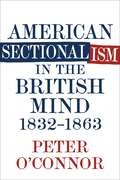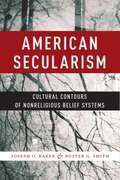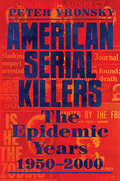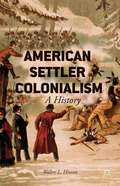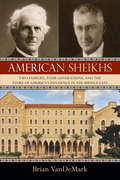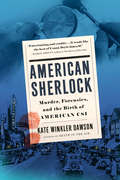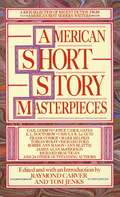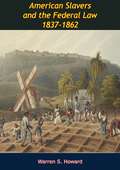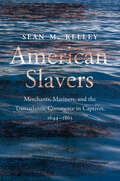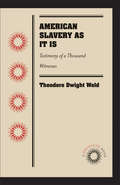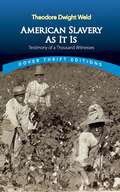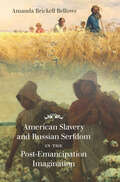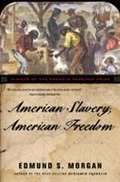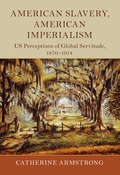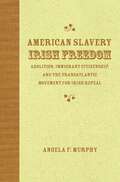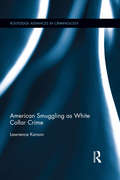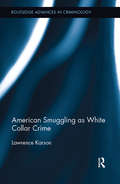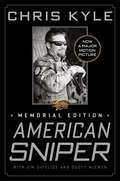- Table View
- List View
American Sectionalism in the British Mind, 1832-1863
by Peter O'ConnorIn American Sectionalism in the British Mind, 1832–1863, Peter O’Connor uses an innovative interdisciplinary approach to provide a corrective to simplified interpretations of British attitudes towards the United States during the antebellum and early Civil War periods. Exploring the many complexities of transatlantic politics and culture, O’Connor examines developing British ideas about U.S. sectionalism, from the abolition of slavery in the British Empire and the Nullification Crisis in South Carolina to the Civil War.Through a close reading of travelogues, fictional accounts, newspaper reports, and personal papers, O’Connor argues that the British literate population had a longstanding familiarity with U.S. sectionalism and with the complex identities of the North and South. As a consequence of their engagement with published accounts of America produced in the decades leading up to the Civil War, the British populace approached the conflict through these preexisting notions.O’Connor reveals even antislavery commentators tended to criticize slavery in the abstract and to highlight elements of the system that they believed compared favorably to the condition of free blacks in the North. As a result, the British saw slavery in the U.S. in national as opposed to sectional terms, which collapsed the moral division between North and South. O’Connor argues that the British identified three regions within America—the British Cavalier South, the British Puritan New England, and the ethnically heterogeneous New York and Pennsylvania region—and demonstrates how the apparent lack of a national American culture prepared Britons for the idea of disunity within the U.S. He then goes on to highlight how British commentators engaged with American debates over political culture, political policy, and states’ rights. In doing so, he reveals the complexity of the British understanding of American sectionalism in the antebellum era and its consequences for British public opinion during the Civil War.American Sectionalism in the British Mind, 1832–1863 re-conceptualizes our understanding of British engagements with the United States during the mid-nineteenth century, offering a new explanation of how the British understood America in the antebellum and Civil War eras.
American Secularism: Cultural Contours of Nonreligious Belief Systems (Religion and Social Transformation #3)
by Joseph O. Baker Buster G. SmithHonorable Mention, American Sociological Association Section on Religion Distinguished Book AwardA rapidly growing number of Americans are embracing life outside the bounds of organized religion. Although America has long been viewed as a fervently religious Christian nation, survey data shows that more and more Americans are identifying as “not religious.” There are more non-religious Americans than ever before, yet social scientists have not adequately studied or typologized secularities, and the lived reality of secular individuals in America has not been astutely analyzed. American Secularism documents how changes to American society have fueled these shifts in the non-religious landscape and examines the diverse and dynamic world of secular Americans.This volume offers a theoretical framework for understanding secularisms. It explores secular Americans’ thought and practice to understand secularisms as worldviews in their own right, not just as negations of religion. Drawing on empirical data, the authors examine how people live secular lives and make meaning outside of organized religion. Joseph O. Baker and Buster G. Smith link secularities to broader issues of social power and organization, providing an empirical and cultural perspective on the secular landscape. In so doing, they demonstrate that shifts in American secularism are reflective of changes in the political meanings of “religion” in American culture.American Secularism addresses the contemporary lived reality of secular individuals, outlining forms of secular identity and showing their connection to patterns of family formation, sexuality, and politics, providing scholars of religion with a more comprehensive understanding of worldviews that do not include traditional religion. Data Analyses Appendix
American Serial Killers: The Epidemic Years 1950-2000
by Peter VronskyFans of Mindhunter and true crime podcasts will devour these chilling stories of serial killers from the American "Golden Age" (1950-2000). With books like Serial Killers, Female Serial Killers and Sons of Cain, Peter Vronsky has established himself as the foremost expert on the history of serial killers. In this first definitive history of the "Golden Age" of American serial murder, when the number and body count of serial killers exploded, Vronsky tells the stories of the most unusual and prominent serial killings from the 1950s to the early twenty-first century. From Ted Bundy to the Golden State Killer, our fascination with these classic serial killers seems to grow by the day. American Serial Killers gives true crime junkies what they crave, with both perennial favorites (Ed Kemper, Jeffrey Dahmer) and lesser-known cases (Melvin Rees, Harvey Glatman).
American Settler Colonialism
by Walter L. Hixson 2013Over the course of three centuries, American settlers helped to create the richest, most powerful nation in human history, even as they killed and displaced millions. This groundbreaking work shows that American history is defined by settler colonialism, providing a compelling framework through which to understand its rise to global dominance.
American Sheikhs
by Brian VandemarkIn addition to their ability to overcome cultural barriers and think independently, the greatest minds in Middle Eastern politics and culture share a common background: they graduated from the American University of Beirut. AUB graduates, whose lives and accomplishments played a significant role in much of the modern history in this critical region of the world, include countless leaders, legislators, ambassadors, educators, scientists, doctors, and businesspeople. Persons such as philosopher and diplomat Charles Malik; Lebanon's former prime minister Fouad Siniora; Arab League ambassador to France Nasif Hitti; and Rula Dashti, one of the first four women to win a seat in Kuwait's House of Parliament, are just a few of the exemplary alumni who embody the ideals of the AUB.In 1866, American missionaries founded a small college in Beirut, Lebanon, called the Syrian Protestant College. Later renamed the American University of Beirut, what began as a humble missionary school grew to become the most influential institution of higher education in the Middle East. Originally created by Reverend Daniel Bliss with the financial backing of businessman William E. Dodge, the AUB, under the leadership of four generations of the Bliss and Dodge families, became the preeminent symbol of American culture and values in the Middle East. This author's vivid narrative not only includes the colorful history of the AUB and many memorable episodes in a dual family saga but also pursues larger and more important themes. In the story of the efforts of these two families to build a great school with alternating audacity, arrogance, generosity, paternalism, and vision, the author clearly sees an allegory for the larger history of the United States in the Middle East.With the ideas of American nationalism and presumptions of Manifest Destiny, arrogant missionaries came to the Middle East in the nineteenth century looking to convert Muslims to Christianity. Through hard experience, these Americans learned to engage Middle Easterners on their own terms--by teaching them, rather than preaching to them. With that, the AUB shifted its focus from religious conversion to educational enlightenment and independent thinking. In doing so, both men and women, whether they be Muslim, Jew, or Christian, generally viewed the school as an engine of constructive change and the United States as a benign force in the region. Long before conflicts over oil, the state of Israel, and military intervention became the prevalent motifs of US involvement in the region, Americans and Middle Easterners encountered one another, learned to work together, and came to understand one another because the AUB served as neutral ground where tolerance and mutual respect prevailed.But in the post-World War II era, with the rise of America as a world power, the AUB found itself buffeted by the strong winds of nationalist frustration, Zionism and anti-Zionism, and eventually Islamic extremism. Middle Easterners became more ambivalent about America's purposes and began to perceive the university not just as a cradle of learning but also as an agent of undesirable Western interests. Despite the tumultuous atmosphere of civil war in Lebanon, foreign invasions throughout the Middle East, and daily riots and bombings in Beirut, the AUB remained intact, holding fast to the ideals of intercultural engagement and mutual regard for diverse points of view.This story is full of meaning today. By revealing how and why the Blisses and Dodges both succeeded and failed in their attempts to influence the Middle East, the author shows how America's outreach in the region can be improved, and he explains the vital importance of maintaining good relations between Americans and the Muslim world in the new century. AThis book tells the story of America giving to, rather than taking from, the nations and peoples of this vitally important yet volatile area. It is a model for how Americans and Middle Easterners of all faiths and perspectives can learn to work together.
American Sherlock: Murder, Forensics, and the Birth of American CSI
by Kate Winkler DawsonFrom the acclaimed author of Death in the Air ("Not since Devil in the White City has a book told such a harrowing tale"--Douglas Preston) comes the riveting story of the birth of criminal investigation in the twentieth century.Berkeley, California, 1933. In a lab filled with curiosities--beakers, microscopes, Bunsen burners, and hundreds upon hundreds of books--sat an investigator who would go on to crack at least two thousand cases in his forty-year career. Known as the "American Sherlock Holmes," Edward Oscar Heinrich was one of America's greatest--and first--forensic scientists, with an uncanny knack for finding clues, establishing evidence, and deducing answers with a skill that seemed almost supernatural.Heinrich was one of the nation's first expert witnesses, working in a time when the turmoil of Prohibition led to sensationalized crime reporting and only a small, systematic study of evidence. However with his brilliance, and commanding presence in both the courtroom and at crime scenes, Heinrich spearheaded the invention of a myriad of new forensic tools that police still use today, including blood spatter analysis, ballistics, lie-detector tests, and the use of fingerprints as courtroom evidence. His work, though not without its serious--some would say fatal--flaws, changed the course of American criminal investigation. Based on years of research and thousands of never-before-published primary source materials, American Sherlock captures the life of the man who pioneered the science our legal system now relies upon--as well as the limits of those techniques and the very human experts who wield them.
American Shoes: A Refugee's Story
by Rosemarie Lengsfeld Turke Garrett TurkeCompiling countless hours of painstaking research, American Shoes is a profound mosaic of memories recounting 15-year-old Rosemarie Lengsfeld Turke&’s escape from Nazi Germany, leaving her life and family behind to forge ahead in an America she left as a small child.Set against a backdrop of Adolf Hitler&’s rise to power, the reign of Nazi Germany, and the entire course of World War II in Europe, American Shoes recounts the tumultuous childhood of a young American girl and her family trapped within a country that turned against itself, where human decency eroded and then vaporized. Forced to grow up in the midst of endemic fear stoked by a ravenous madman, American Shoes portrays the breakdown of a society from a child&’s point of view, deep inside a land where millions of law-abiding citizens were targeted as threats, and then removed for extermination. This is the story of a brave girl who, despite not being Jewish, was perceived to be one of those threats and was compelled to keep her American identity secret for fear of her family&’s arrest, concentration camp placement, or worse. Fighting to see through a relentless barrage of Nazi lies and propaganda, caught within a nation where resistance or opposition meant incarceration if not certain death, American Shoes illuminates one family&’s struggle to survive against impossible odds as a cataclysmic world war marched closer and closer until it was upon them. Vividly told for the first time after seven decades of a family&’s collective silence, American Shoes reveals the story of a brave and spirited young girl named Rosel who refused to accept the new order of a world gone mad, inside a society that became more sinister and macabre than any childhood nightmare could ever be. Driven by the faint memories of the land where she was born—a hazy beacon that guided her toward freedom and a new life—this is the story of Rosemarie Lengsfeld Turke.
American Short Story Masterpieces
by Raymond Carver Tom JenksThis highly acclaimed collection of short stories by American writers contains only the best literary art of the past four decades. With a bias toward realism, editors Raymond Carver and Tom Jenks have selected fiction that "tells a story" and tells it with a masterful handling of language, situation, and insight. But what is so special about this volume is that it mirrors our age, our concerns, and our lives. Whether it's the end of a marriage, as in Bobbie Ann Manson's "Shiloh," or the struggle with self-esteem and weight in Andre Dubus's "The Fat Girl," the 36 works included her probe issues that give us that "shock of recognition" that is the hallmark of great art--wonderful, absorbing fiction that will be read and reread for decades to come.
American Showman: Samuel "Roxy" Rothafel and the Birth of the Entertainment Industry, 1908–1935 (Film and Culture Series)
by Ross MelnickSamuel "Roxy" Rothafel (1882–1936) built an influential and prolific career as film exhibitor, stage producer, radio broadcaster, musical arranger, theater manager, war propagandist, and international celebrity. He helped engineer the integration of film, music, and live performance in silent film exhibition; scored early Fox Movietone films such as Sunrise (1927); pioneered the convergence of film, broadcasting, and music publishing and recording in the 1920s; and helped movies and moviegoing become the dominant form of mass entertainment between the world wars. <P><P>The first book devoted to Rothafel's multifaceted career, American Showman examines his role as the key purveyor of a new film exhibition aesthetic that appropriated legitimate theater, opera, ballet, and classical music to attract multi-class audiences. Roxy scored motion pictures, produced enormous stage shows, managed many of New York's most important movie houses, directed and/or edited propaganda films for the American war effort, produced short and feature-length films, exhibited foreign, documentary, independent, and avant-garde motion pictures, and expanded the conception of mainstream, commercial cinema. He was also one of the chief creators of the radio variety program, pioneering radio broadcasting, promotions, and tours.The producers and promoters of distinct themes and styles, showmen like Roxy profoundly remade the moviegoing experience, turning the deluxe motion picture theater into a venue for exhibiting and producing live and recorded entertainment. Roxy's interest in media convergence also reflects a larger moment in which the entertainment industry began to create brands and franchises, exploit them through content release "events," and give rise to feature films, soundtracks, broadcasts, live performances, and related consumer products. Regularly cited as one of the twelve most important figures in the film and radio industries, Roxy was instrumental to the development of film exhibition and commercial broadcasting, musical accompaniment, and a new, convergent entertainment industry.
American Sirens: The Incredible Story of the Black Men Who Became America's First Paramedics
by Kevin HazzardThe extraordinary story of an unjustly forgotten group of Black men in Pittsburgh who became the first paramedics in America, saving lives and changing the course of emergency medicine around the world Until the 1970s, if you suffered a medical crisis, your chances of survival were minimal. A 9-1-1 call might bring police or even the local funeral home. But that all changed with Freedom House EMS in Pittsburgh, a group of Black men who became America&’s first paramedics and set the gold standard for emergency medicine around the world, only to have their story and their legacy erased—until now.In American Sirens, acclaimed journalist and paramedic Kevin Hazzard tells the dramatic story of how a group of young, undereducated Black men forged a new frontier of healthcare. He follows a rich cast of characters that includes John Moon, an orphan who found his calling as a paramedic; Peter Safar, the Nobel Prize-nominated physician who invented CPR and realized his vision for a trained ambulance service; and Nancy Caroline, the idealistic young doctor who turned a scrappy team into an international leader. At every turn, Freedom House battled racism—from the community, the police, and the government. Their job was grueling, the rules made up as they went along, their mandate nearly impossible—and yet despite the long odds and fierce opposition, they succeeded spectacularly. Never-before revealed in full, this is a rich and troubling hidden history of the Black origins of America&’s paramedics, a special band of dedicated essential workers, who stand ready to serve day and night on the line between life and death for every one of us.
American Sketches: Great Leaders, Creative Thinkers, and Heroes of a Hurricane
by Walter IsaacsonWhat are the roots of creativity? What makes for great leadership? How do influential people end up rippling the surface of history? In this collection of essays, Walter Isaacson reflects on the lessons to be learned from Benjamin Franklin, Albert Einstein, Bill Gates, Henry Kissinger, Ronald Reagan and Mikhail Gorbachev, Hillary Clinton and Bill Clinton, and various other interesting characters he has chronicled as a biographer and journalist. The people he writes about have an awesome intelligence, in most cases, but that is not the secret of their success. They had qualities that were even more rare, such as imagination and true curiosity. Isaacson reflects on how he became a writer, the lessons he learned from various people he met, and the challenges he sees for journalism in the digital age. He also offers loving tributes to his hometown of New Orleans, which both before and after Hurricane Katrina offered many of the ingredients for a creative culture, and to the Louisiana novelist Walker Percy, who was an early mentor. In an anecdotal and personal way, Isaacson describes the joys of the "so-called writing life" and the way that tales about the lives of fascinating people can enlighten our own lives.
American Slavers and the Federal Law 1837-1862
by Warren S. HowardDetailed study of the American government's inability to deal with flagrant violations of federal laws forbidding the use of American citizens, vessels, and port facilities in the international slave trade which flourished in the 1840s and 1850s.
American Slavers: Merchants, Mariners, and the Transatlantic Commerce in Captives, 1644-1865
by Sean M. KelleyThe first telling of the unknown story of America’s two-hundred-year history as a slave-trading nation A total of 305,000 enslaved Africans arrived in the New World aboard American vessels over a span of two hundred years as American merchants and mariners sailed to Africa and to the Caribbean to acquire and sell captives. Using exhaustive archival research, including many collections that have never been used before, historian Sean M. Kelley argues that slave trading needs to be seen as integral to the larger story of American slavery. Engaging with both African and American history and addressing the trade over time, Kelley examines the experience of captivity, drawing on more than a hundred African narratives to offer a portrait of enslavement in the regions of Africa frequented by American ships. Kelley also provides a social history of the two American ports where slave trading was most intensive, Newport and Bristol, Rhode Island. In telling this tragic, brutal, and largely unknown story, Kelley corrects many misconceptions while leaving no doubt that Americans were a nation of slave traders.
American Slavery As It Is
by Theodore Dwight WeldCompiled by a prominent abolitionist Theodore Dwight Weld, American Slavery As It Is combines information taken from witnesses, and from active and former slave owners, to generate a condemnation of slavery from both those who observed it and those who perpetuated it. The narrative describes the appalling day-to-day conditions of the over 2,700,000 men, women and children in slavery in the United States. Weld demonstrates how even prisoners--in the United States and in other countries--were significantly better fed than American slaves. Readers will find one of the most meticulous records of slave life available in this text. Unlike personal slave narratives, which focus on a single man or woman's experience, American Slavery details the overall conditions of slaves across multiple states and several years. A DOCSOUTH BOOK. This collaboration between UNC Press and the University of North Carolina at Chapel Hill Library brings selected classic works from the digital library of Documenting the American South back into print. DocSouth Books uses the latest digital technologies to make these works available as downloadable e-books or print-on-demand publications. DocSouth Books are unaltered from the original publication, providing affordable and easily accessible editions to a new generation of scholars, students, and general readers.
American Slavery As It Is: Selections from the Testimony of a Thousand Witnesses (Dover Thrift Editions)
by Theodore Dwight WeldThe stories of hundreds of African-Americans who lived in bondage are preserved in this powerful 1839 chronicle. Compiled by a prominent abolitionist, the accounts include personal narratives from freed slaves as well as testimonials from active and former slave owners, presenting a condemnation of slavery from both those who experienced it and those who perpetuated it. Detailing the overall conditions of slaves across multiple states and several years, the book includes information on their diet, clothing, housing, and working hours as well as their punishments and suffering.Connecticut farmer-turned-abolitionist Theodore Dwight Weld (1803–1895) was a central leader of the American Anti-Slavery Society and traveled the country lecturing against slavery. Weld took great pains to document the trustworthiness of contributors to American Slavery so that there could be no doubt as to its authenticity. A major influence on Harriet Beecher Stowe's Uncle Tom's Cabin, the book sold 100,000 copies in its first year of publication and remains a valuable historical testament. This edited selection presents these powerful first-person accounts to a new generation.
American Slavery and Russian Serfdom in the Post-Emancipation Imagination
by Amanda Brickell BellowsThe abolition of Russian serfdom in 1861 and American slavery in 1865 transformed both nations as Russian peasants and African Americans gained new rights as subjects and citizens. During the second half of the long nineteenth century, Americans and Russians responded to these societal transformations through a fascinating array of new cultural productions. Analyzing portrayals of African Americans and Russian serfs in oil paintings, advertisements, fiction, poetry, and ephemera housed in American and Russian archives, Amanda Brickell Bellows argues that these widely circulated depictions shaped collective memory of slavery and serfdom, affected the development of national consciousness, and influenced public opinion as peasants and freedpeople strove to exercise their newfound rights. While acknowledging the core differences between chattel slavery and serfdom, as well as the distinctions between each nation's post-emancipation era, Bellows highlights striking similarities between representations of slaves and serfs that were produced by elites in both nations as they sought to uphold a patriarchal vision of society. Russian peasants and African American freedpeople countered simplistic, paternalistic, and racist depictions by producing dignified self-representations of their traditions, communities, and accomplishments. This book provides an important reconsideration of post-emancipation assimilation, race, class, and political power.
American Slavery, American Freedom
by Edmund S. Morgan"Thoughtful, suggestive and highly readable."--New York Times Book Review In the American Revolution, Virginians were the most eloquent spokesmen for freedom and quality. George Washington led the Americans in battle against British oppression. Thomas Jefferson led them in declaring independence. Virginians drafted not only the Declaration but also the Constitution and the Bill of Rights; they were elected to the presidency of the United States under that Constitution for thirty-two of the first thirty-six years of its existence. They were all slaveholders. In the new preface Edmund S. Morgan writes: "Human relations among us still suffer from the former enslavement of a large portion of our predecessors. The freedom of the free, the growth of freedom experienced in the American Revolution depended more than we like to admit on the enslavement of more than 20 percent of us at that time. How republican freedom came to be supported, at least in large part, by its opposite, slavery, is the subject of this book. American Slavery, American Freedom is a study of the tragic contradiction at the core of America. Morgan finds the keys to this central paradox, "the marriage of slavery and freedom," in the people and the politics of the state that was both the birthplace of the Revolution and the largest slaveholding state in the country.
American Slavery, American Freedom: The Ordeal of Colonial Virginia
by Edmund Sears MorganGeorge Washington, Thomas Jefferson, and other Virginians led the battle against British oppression and drafted the country's founding documents, yet they were also slaveholders. Morgan (history emeritus, Yale University) examines the tragic contradiction at the core of America, looking at the people and politics of the state that was both the birthplace of the Revolution and the largest slave holding state in the country. The book was first published in 1975 by W. W. Norton and Company. This reprint includes a new preface by the author.
American Slavery, American Imperialism: US Perceptions of Global Servitude, 1870–1914 (Slaveries since Emancipation)
by Catherine ArmstrongSlavery casts a long shadow over American history; despite the cataclysmic changes of the Civil War and emancipation, the United States carried antebellum notions of slavery into its imperial expansion at the turn of the twentieth-century. African American, Chinese and other immigrant labourers were exploited in the name of domestic economic development, and overseas, local populations were made into colonial subjects of America. How did the U.S. deal with the paradox of presenting itself as a global power which abhorred slavery, while at the same time failing to deal with forced labour at home? Catherine Armstrong argues that this was done with rhetorical manoeuvres around the definition of slavery. Drawing primarily on representations of slavery in American print culture, this study charts how definitions and depictions of slavery both changed and stayed the same as the nation became a prominent actor on the world stage. In doing so, Armstrong challenges the idea that slavery is a merely historical problem, and shows its relevance in the contemporary world.
American Slavery, Irish Freedom: Abolition, Immigrant Citizenship, and the Transatlantic Movement for Irish Repeal (Antislavery, Abolition, and the Atlantic World)
by Angela F. MurphyIrish Americans who supported the movement for the repeal of the act of parliamentary union between Ireland and Great Britain during the early 1840s encountered controversy over the issue of American slavery. Encouraged by abolitionists on both sides of the Atlantic, repeal leader Daniel O'Connell often spoke against slavery, issuing appeals for Irish Americans to join the antislavery cause. With each speech, American repeal associations debated the proper response to such sentiments and often chose not to support abolition. In American Slavery, Irish Freedom, Angela F. Murphy examines the interactions among abolitionists, Irish nationalists, and American citizens as the issues of slavery and abolition complicated the first transatlantic movement for Irish independence.The call of Old World loyalties, perceived duties of American citizenship, and regional devotions collided for these Irish Americans as the slavery issue intertwined with their efforts on behalf of their homeland. By looking at the makeup and rhetoric of the American repeal associations, the pressures on Irish Americans applied by both abolitionists and American nativists, and the domestic and transatlantic political situation that helped to define the repealers' response to antislavery appeals, Murphy investigates and explains why many Irish Americans did not support abolitionism. Murphy refutes theories that Irish immigrants rejected the abolition movement primarily for reasons of religion, political affiliation, ethnicity, or the desire to assert a white racial identity. Instead, she suggests, their position emerged from Irish Americans' intention to assert their loyalty toward their new republic during what was for them a very uncertain time.The first book-length study of the Irish repeal movement in the United States, American Slavery, Irish Freedom conveys the dilemmas that Irish Americans grappled with as they negotiated their identity and adapted to the duties of citizenship within a slaveholding republic, shedding new light on the societal pressures they faced as the values of that new republic underwent tremendous change.
American Slavery: A Very Short Introduction (Very Short Introductions)
by Heather Andrea WilliamsEuropeans, Africans, and American Indians practiced slavery long before the first purchase of a captive African by a white land-owner in the American colonies; that, however, is the image of slavery most prevalent in the minds of Americans today. This Very Short Introduction begins with the Portuguese capture of Africans in the 1400s and traces the development of American slavery until its abolition following the Civil War. Historian Heather Andrea Williams draws upon the rich recent scholarship of numerous highly-regarded academics as well as an analysis of primary documents to explore the history of slavery and its effects on the American colonies and later the United States of America.
American Slaves and African Masters
by Christine E. SearsWhether by falling prey to Algerian corsairs or crashing onto the desert shores of Western Sahara, a handful of Americans in the first years of the Republic found themselves enslaved in a system that differed so markedly from nineteenth century U. S. slavery that some contemporaries and modern scholars hesitate to categorize their experiences as 'slavery. ' Sears uses a comparative approach, placing African enslavement of Americans and Europeans in the context of Mediterranean and Ottoman slaveries, while individually investigating the system of slavery in Algiers and Western Sahara. This work illuminates the commonalities and peculiarities of these slaveries, while contributing to a growing body of literature that showcases the flexibility of slavery as an institution.
American Smuggling as White Collar Crime (Routledge Advances in Criminology #17)
by Lawrence KarsonWhen Edwin Sutherland introduced the concept of white-collar crime, he referred to the respectable businessmen of his day who had, in the course of their occupations, violated the law whenever it was advantageous to do so. Yet since the founding of the American Republic, numerous otherwise respectable individuals had been involved in white-collar criminality. Using organized smuggling as an exemplar, this narrative history of American smuggling establishes that white-collar crime has always been an integral part of American history when conditions were favorable to violating the law. This dark side of the American Dream originally exposed itself in colonial times with elite merchants of communities such as Boston trafficking contraband into the colonies. It again came to the forefront during the Embargo of 1809 and continued through the War of 1812, the Civil War, nineteenth century filibustering, the Mexican Revolution and Prohibition. The author also shows that the years of illegal opium trade with China by American merchants served as precursor to the later smuggling of opium into the United States. The author confirms that each period of smuggling was a link in the continuing chain of white-collar crime in the 150 years prior to Sutherland’s assertion of corporate criminality.
American Smuggling as White Collar Crime (Routledge Advances in Sociology #17)
by Lawrence KarsonWhen Edwin Sutherland introduced the concept of white-collar crime, he referred to the respectable businessmen of his day who had, in the course of their occupations, violated the law whenever it was advantageous to do so. Yet since the founding of the American Republic, numerous otherwise respectable individuals had been involved in white-collar criminality. Using organized smuggling as an exemplar, this narrative history of American smuggling establishes that white-collar crime has always been an integral part of American history when conditions were favorable to violating the law.This dark side of the American Dream originally exposed itself in colonial times with elite merchants of communities such as Boston trafficking contraband into the colonies. It again came to the forefront during the Embargo of 1809 and continued through the War of 1812, the Civil War, nineteenth century filibustering, the Mexican Revolution and Prohibition. The author also shows that the years of illegal opium trade with China by American merchants served as precursor to the later smuggling of opium into the United States. The author confirms that each period of smuggling was a link in the continuing chain of white-collar crime in the 150 years prior to Sutherland’s assertion of corporate criminality.
American Sniper: The Autobiography of the Most Lethal Sniper in U. S. Military History
by Jim Defelice Chris Kyle Scott McewenA celebration of the remarkable life and legacy of fallen American hero Chris Kyle<P> This commemorative memorial edition of Kyle's bestselling memoir features the full text of American Sniper, plus more than eighty pages of remembrances by those whose lives he touched personally--including his wife, Taya; his parents, brother, and children; Marcus Luttrell and other fellow Navy SEALs; veterans and wounded warriors; lifelong friends; and many others.<P> He was the top American sniper of all time, called "the legend" by his Navy SEAL brothers, and a hero by those he served on the home front . . .From 1999 to 2009, U.S. Navy SEAL Chris Kyle recorded the most career sniper kills in United States military history. Kyle earned legendary status among his fellow SEALs, Marines, and U.S. Army soldiers, whom he protected with deadly accuracy from rooftops and stealth positions. Gripping and unforgettable, Kyle's masterful account of his extraordinary battlefield experiences ranks as one of the greatest war memoirs of all time.<P> A native Texan who learned to shoot on childhood hunting trips with his father, Kyle was a champion saddle-bronc rider prior to joining the Navy. After 9/11, he was thrust onto the front lines of the War on Terror, and soon found his calling as a world-class sniper who performed best under fire. He recorded a personal-record 2,100-yard kill shot outside Baghdad; in Fallujah, Kyle braved heavy fire to rescue a group of Marines trapped on a street; in Ramadi, he stared down insurgents with his pistol in close combat. Kyle talks honestly about the pain of war--of twice being shot, and experiencing the tragic deaths of two close friends.American Sniper also honors Kyle's fellow warriors, who raised hell on and off the battlefield. And in moving first-person accounts throughout, Kyle's wife, Taya, speaks openly about the strains of war on their marriage and children, as well as on Chris.<P> Adrenaline-charged and deeply personal, American Sniper is a thrilling eyewitness account of service and sacrifice that only one man could tell.
